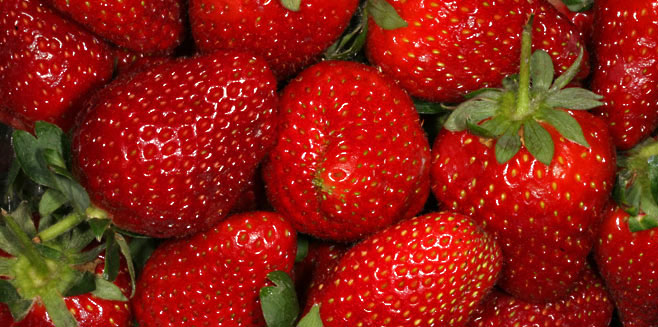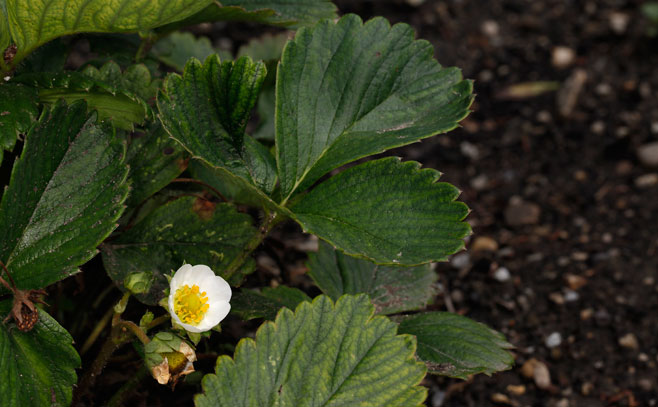Genus: Fragaria (strawberries) Life
> eukaryotes >
Archaeoplastida >
Chloroplastida
>
Charophyta > Streptophytina > Plantae (land plants)
> Tracheophyta (vascular plants) > Euphyllophyta > Lignophyta (woody plants)
> Spermatophyta (seed plants) > Angiospermae (flowering
plants) > Eudicotyledons > Core Eudicots > Rosids >
Eurosid I > Order: Rosales > Family: Rosaceae
 |
|
Fragaria ananassa (Modern Garden
Strawberry), a hybrid from other species, is the strawberry as we know
it today. [photo
H.G.
Robertson, Iziko ©] |
 |
 |
|
Fragaria x ananassa, Vienna Botanical
Gardens, Austria. [photos
H.G.
Robertson, Iziko ©] |
Strawberry fruit are eaten raw or used in making juice,
desserts, jam, syrup and wine. Fruit, leaves and roots are also used
medicinally. The Modern Garden Strawberry Fragaria ananassa, which is the
main species grown these days, arose in the gardens of Europe as a hybrid
between two New World species that had been introduced to Europe by the Spanish
colonists.
There are 12 or so species of Fragaria and the
genus is native to the north temperate regions (Eurasia, North America), and
also extends into North Africa and down through tropical American mountains
into temperate South America (e.g. Chile). The number of sets of chromosomes
varies from species to species ranging from 2 sets in the Wild Strawberry Fragaria
vesca to 8 sets in the Modern Garden Strawberry Fragaria ananassa.
In a strict botanical sense, the strawberry fruit is not a
true fruit, but is termed a pseudocarp. Fragaria belongs to
the family Rosaceae in which there are a whole lot of
individual female reproductive organs, termed carpels, in the flower.
Each carpel consists of a stigma, style and ovary and all
the carpels are inserted on to a fleshy receptacle. In Fragaria,
the receptacle swells into the red-coloured 'fruit' we know as a strawberry and
over its surface are black dots, each dot being an individual true fruit (a true
fruit being the ripened ovary). The individual true fruit are termed achenes
these being small, dry single seeded fruit that do not split open. It is
interesting to contrast the strawberry with the Blackberry (or any other species
in the genus Rubus) which is also in the Rosaceae
and which also has multiple carpels inserted on a receptacle. Instead of the
receptacle swelling to form the fruit, the individual ovaries of the carpels
become black and fleshy and in combination they form the Blackberry. So strictly
speaking, the Blackberry is also not a true fruit but an aggregation of separate
fruit, but in a loose botanical sense, it is OK to call strawberries and
blackberries fruit.
Strawberries are eaten by birds which disperse the seeds
widely. Strawberry plants also spread vegetatively using runners and this
enables them to be easily transplanted and propagated as clones. Strawberry
species are generally dioecious (male and female flowers on separate plants) but
hermaphroditic flowers did occur rarely in the wild and these were selected for
in domestication because it simplified crop production and enabled a crop to all
be cloned from a single source.
The Wild Strawberry or Wood Strawberry Fragaria vesca
is native to the temperate regions of Eurasia and North America. It has become
distributed worldwide and is sometimes
found naturalised in southern Africa. It is a diploid species (i.e. 2
sets of chromosomes).The finding of strawberry achenes in neolithic
archaeological excavations, shows that wild strawberries have been eaten by
people since the earliest of times. Fragaria vesca was being cultivated
in Europeans gardens by the 1500's (Renaissance) and after about 1530,
cultivated strawberries are clearly larger than wild ones, indicating selective
breeding. Although Fragaria vesca is still grown in gardens for domestic
use, it is not used in commercial strawberry production because of the
development of the Modern Garden Strawberry Fragaria ananassa.
The Hautbois or Musk Strawberry Fragaria moschata
is native to highland areas from France through to Siberia. It is a hexaploid
species (i.e. 6 sets of chromosomes). Like Fragaria vesca, it
started being cultivated in European gardens from the 1500's and was still being
cultivated widely in the 1600's. However, with the arrival of Fragaria
virginiana and Fragaria chiloensis from the New World, growing of
this species became severely curtailed in favour of these new, more favourable
species and especially the new Modern Garden Strawberry that arose through
hybridization of these two species.
The Virginia Strawberry Fragaria virginiana is
native to North America and its flavour, size and abundance made it a popular
fruit amongst Indian tribes and also amongst European colonists. During the
1620's, it started being cultivated in Europe. It is an octoploid (8 sets
of chromosomes). The Chilean Strawberry Fragaria chiloensis
is also an octoploid and native from Alaska to California. It also evidently
became dispersed in prehistoric times by birds to Hawaii, Chile and Argentina.
It had been domesticated by the Araucanians in Chile before the Spaniards
arrived. They selected for large-fruited varieties. The colonists spread it
widely within Central and South America but it was evidently only introduced to
Europe in the early 1700's.
The Modern Garden Strawberry Fragaria ananassa
is also an octoploid. It is a hybrid between the domesticated Fragaria
virginiana with its hermaphrodite flowers and tasty fruit, and Fragaria
chiloensis with its large fruit. The hybrid arose within Europe and might
have done so a number of times, whenever the two parent species were
interplanted. It is of such superior size and quality that it has become the
main species in commercial strawberry production. Strawberry varieties have been
selected to favour particular climates and to be day-length neutral so that they
flower and fruit under both short and long day lengths, thus enabling them to be
harvested over a long season in frost-free regions.
Uses
Strawberry fruit are eaten raw or used in making juice,
desserts, jam, syrup and wine. Leaves are used in blended herbal teas.
Leaves and roots are believed to have medicinal benefits in terms of easing
diarrhoea, digestive upsets and gout. The fruit juice is evidently used
externally to counteract sunburn, skin blemishes and discoloured teeth.
References
-
Brown, D. 2002. The Royal Horticultural
Society New Encyclopedia of Herbs and their Uses. Dorling Kindersley,
London.
-
Sauer, J.D. 1993. Historical geography of
crop plants - a select roster. CRC Press, Boca Raton, Florida.
Text by Hamish Robertson
|
